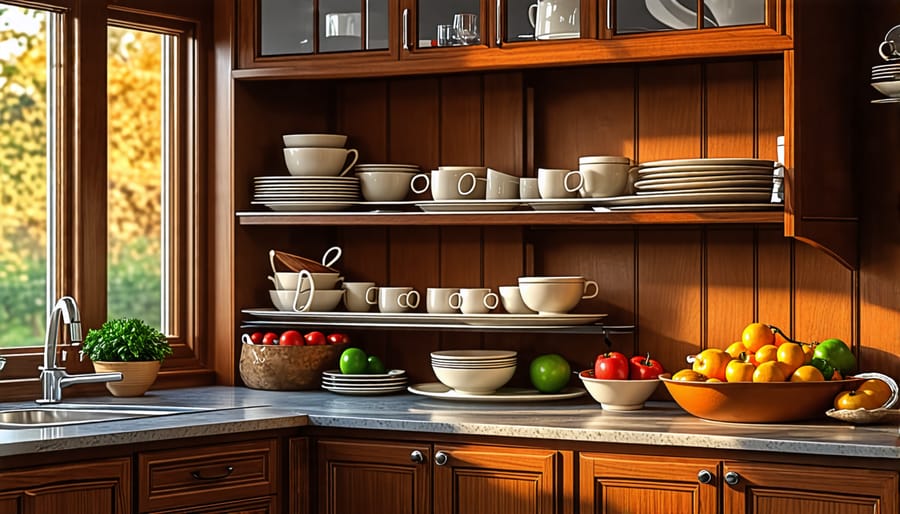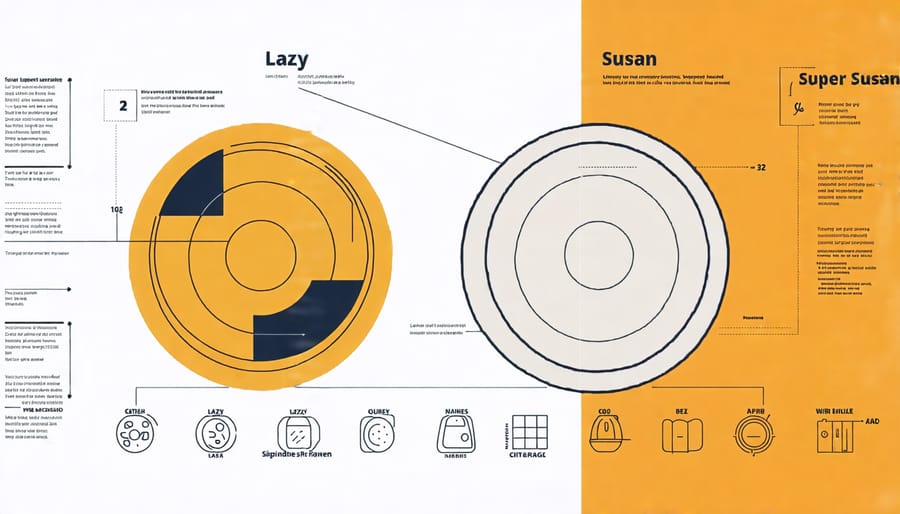Revolutionize your cabinets with the ultimate showdown: lazy susans vs super susans. These spinning wonders transform cluttered shelves into organized havens, but which reigns supreme? Lazy susans, the classic choice, offer 360-degree accessibility and effortless rotation for everyday essentials. Super susans, the turbo-charged newcomer, boast multi-level designs and smooth, heavy-duty bearings to handle even your heftiest pots and pans. Discover which of these kitchen cabinet organizers will elevate your storage game as we dive deep into their unique features, pros and cons, and expert tips for choosing the perfect spinning solution for your space. Get ready to give your cabinets a whirl and kiss chaos goodbye.
What is a Lazy Susan?
A lazy susan is a rotating tray or platform designed to make items in hard-to-reach spaces more accessible. Typically circular in shape, lazy susans are commonly made from wood, plastic, or metal and feature a spinning mechanism that allows the tray to rotate 360 degrees. This design enables users to easily access items placed on the lazy susan without having to reach deep into cabinets or pantries.
Lazy susans are often installed in corner cabinets, where their rotating functionality makes efficient use of awkward, hard-to-reach spaces. By simply spinning the tray, users can quickly locate and retrieve items that would otherwise be difficult to access. Lazy susans are also commonly used in pantries, where they can help organize and provide easy access to a variety of food items, condiments, or spices.
The size and style of lazy susans can vary depending on the specific application and the dimensions of the cabinet or pantry. Some lazy susans feature multiple tiers, allowing for even greater storage capacity and organization. Whether in the kitchen, bathroom, or other storage areas, lazy susans offer a simple and effective solution for making the most of your available space and keeping items organized and within reach.

What is a Super Susan?
A super susan, also known as a double-decker lazy susan, takes the convenience of a traditional lazy susan to the next level. While a standard lazy susan consists of a single rotating tray, a super susan features two spinning trays stacked on top of each other. This innovative design allows for even more storage space and organization possibilities in your kitchen cabinets or on your countertops.
The double-decker design of a super susan is its most distinguishing feature. The two spinning trays are usually separated by a sturdy central shaft, which allows them to rotate independently of each other. This means you can store and access items on both levels without having to remove items from the top tray to reach the bottom one.
Super susans are often larger in diameter than regular lazy susans, providing ample space for storing a wide variety of items. The top tray is typically shallower than the bottom one, making it ideal for storing smaller items like spices, condiments, or tea bags. The bottom tray, with its increased depth, is perfect for holding taller items such as bottles, jars, or cans.
Another unique feature of some super susans is the presence of removable dividers on one or both trays. These dividers help keep items organized and prevent them from shifting around as the tray rotates. This added functionality makes super susans even more versatile and practical for kitchen organization.


Key Differences Between Lazy Susans and Super Susans
Capacity and Organization
When it comes to storage capacity, super susans typically offer more space than traditional lazy susans. With their larger diameter and multi-tiered design, super susans can accommodate a greater number of items, making them ideal for bigger kitchens or those with extensive cookware collections. However, lazy susans still provide ample storage for most households and can be a great choice for smaller spaces.
In terms of organization, both lazy susans and super susans excel at keeping items easily accessible and neatly arranged. Lazy susans allow you to categorize items by type or frequency of use, while super susans take it a step further with their multiple levels, enabling you to separate and organize items even more effectively. Whether you opt for a lazy susan or a super susan, these handy kitchen tools will undoubtedly streamline your storage and make meal prep a breeze.
Ease of Use and Installation
When it comes to ease of use and installation, both lazy susans and super susans offer user-friendly solutions for organizing your kitchen. Lazy susans are incredibly simple to install, often requiring no tools or hardware. Simply place the lazy susan on your shelf or countertop, and you’re ready to start organizing. Super susans, while slightly more complex, are still relatively easy to install. Most models come with clear instructions and necessary hardware, allowing for a straightforward DIY installation process. However, some super susan designs may require minor carpentry skills or the assistance of a professional for a seamless fit. Once installed, both types of spinning organizers provide effortless access to your items, making meal preparation and cleanup a breeze. With a gentle spin, you can quickly locate and retrieve the ingredients or tools you need, saving time and frustration in the kitchen.
Price and Aesthetics
When it comes to price, lazy susans are typically more affordable than super susans. You can find basic lazy susan models starting around $10-$20, while higher-end options with better materials and finishes may cost $50-$100. Super susans, being a more advanced solution, tend to fall in the $100-$300 range depending on size, features, and quality.
Aesthetically, lazy susans offer a wider variety of styles to match your kitchen decor. They come in materials like wood, plastic, metal, and bamboo, with finishes ranging from natural to painted or stained. Some feature decorative edges or inlaid patterns for added visual interest. Super susans have a more streamlined, built-in look since they’re designed to blend seamlessly with your cabinets. While they may have fewer style options, they provide a clean, custom appearance that enhances the overall look of your kitchen.
Pros and Cons
Lazy Susan Pros and Cons
Lazy susans offer several advantages for kitchen organization. They make items easily accessible by rotating, saving you from rummaging through cluttered cabinets. Lazy susans maximize corner cabinet space, utilizing areas that are otherwise hard to reach. They also keep items neatly contained and visible, making it simple to find what you need.
However, lazy susans have some drawbacks. They have a fixed number of tiers, limiting customization options. Larger items may not fit well, and the spinning motion can cause items to fall off if not properly secured. Lazy susans also require regular maintenance to ensure smooth rotation and prevent jamming. Additionally, the center pole can obstruct storage space, and you may need to remove all items to clean thoroughly.
Super Susan Pros and Cons
Super susans offer several advantages over traditional lazy susans. Their larger size provides more storage space, accommodating bulkier items like appliances or oversized containers. The sturdier construction and higher weight capacity make them ideal for heavy items like cast iron cookware. Super susans also come in a wider range of materials, including wood and stainless steel, allowing for more customization to match your kitchen decor.
However, super susans have some drawbacks to consider. Their larger size may not fit in smaller cabinets or tight spaces. They also tend to be more expensive than standard lazy susans due to their enhanced features and materials. Additionally, the increased weight capacity can make them more difficult to rotate, especially when fully loaded. Consider your specific needs and kitchen layout when deciding if a super susan is the right choice for you.
Which One is Right For You?
When deciding between a lazy susan and a super susan for your kitchen, consider your unique needs, available space, and budget. Lazy susans are ideal for smaller corners or cabinets, offering a simple and affordable way to maximize storage and accessibility. They’re perfect for organizing spices, condiments, or small pantry items.
On the other hand, super susans are designed for larger spaces and heavier items. With their sturdy construction and multiple tiers, they can handle bulkier items like pots, pans, and small appliances. Super susans are a great choice if you have deep corner cabinets or want to store a variety of items in one convenient location.
When making your decision, think about what you’ll be storing and how much weight the organizer needs to support. Measure your cabinet dimensions carefully to ensure a proper fit. Interior design expert Sarah Johnson suggests, “Consider the height of your items and the clearance needed for easy access. Make sure the susan can spin freely without obstruction.”
Budget is another factor to keep in mind. Lazy susans are generally more affordable, while super susans come with a higher price tag due to their larger size and extra features. However, investing in a quality organizer can save you time and frustration in the long run.
Ultimately, the right choice depends on your specific kitchen layout and organization goals. By assessing your needs and space constraints, you can select the perfect susan to keep your kitchen clutter-free and efficiently organized.
Conclusion
In conclusion, lazy susans and super susans both offer effective solutions for kitchen organization, but they differ in their design, capacity, and ideal use cases. Lazy susans are best suited for smaller items and spaces, while super susans excel in larger cabinets and pantries, accommodating bulkier items. When deciding between the two, consider your available space, the types of items you need to store, and your budget. Think about your unique kitchen layout and storage needs to determine which option will work best for you. With the right choice, you can maximize your storage space, improve accessibility, and create a more efficient and organized kitchen.